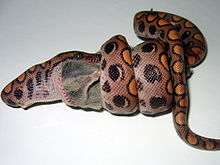Constriction
Constriction is a method used by various snake species to kill their prey. Although some species of venomous and mildly venomous snakes do use constriction to subdue their prey, most snakes which use constriction lack venom.[1] The snake initially strikes at its prey and holds on, pulling the prey into its coils or, in the case of very large prey, pulling itself onto the prey. The snake will then wrap one or two coils around the prey. The snake will monitor the prey's heartbeat to ascertain when it is dead.[2][3][4]

Contrary to myth, the snake does not crush the prey, or break its bones. Also, contrary to previous belief, the snake does not cause suffocation by constricting the victim. Instead, a study of death caused by boa constrictors, showed that constriction "shuts off" blood flow (and therefore oxygen) needed by vital organs such as the heart and brain, which would lead to unconsciousness and death very quickly – in seconds – in other words, constriction can interrupt blood flow and overwhelm the prey's usual blood pressure and circulation.[5] Artery pressure drops, vein pressure increases, and blood vessels begin to close. The heart does not have enough strength to pump against the pressure and blood flow stops. Internal organs with high metabolic rates, including the brain, liver, and the heart begin to stop and die due to ischemia, a loss of oxygen and glucose. There is evidence that boa constrictors have more difficulty killing ectotherms, animals like lizards and snakes that rely on external heat to regulate their body temperatures. A boa constrictor was observed attacking a spinytail iguana for an hour, and the iguana survived.[6][7]
As this is comparatively recent research (2015), it is possible that other constrictors kill in other ways. It had previously been accepted that constrictors used their body to hold the prey tight and prevent the prey from drawing air into its lungs, resulting in death from asphyxia,[8] or that the pressure of constriction causes a rise in the pressure in the prey's body cavity greater than the heart can counter, resulting in immediate cardiac arrest;[9] data from earlier studies had also indicated that snakes can exert enough pressure for these to be plausible.[10]
Certain groups of snakes have characteristic patterns of constriction, including the number of coils they use and the orientation of the coils.[11][12]
Venomous snakes that also use constriction include the mussuranas (ophiophagous South American mildly venomous rear-fanged colubrids which use constriction to subdue snakes including pit vipers), the western terrestrial garter snake (North American colubrid which is an inefficient constrictor and, like most Thamnophis garter snakes, mildly venomous),[13][14] some species of Boiga snakes (Asian and Australian rear-fanged colubrids) including the brown tree snake (Boiga irregularis),[13][15][16] some species of Australian elapids (including some of the venomous Pseudonaja brown snakes and one Australian coral snake Simoselaps), and a few Australian colubrids.[17]
External links
See also
References
- ↑ Shine, R.; Schwaner, T. (1985). "Prey Constriction by Venomous Snakes: A Review, and New Data on Australian Species". Copeia. 1985 (4): 1067–1071. doi:10.2307/1445266. JSTOR 1445266.
- ↑ Powell, Devin (25 Feb 2012). "Boas take pulse as they snuff it out". Science News. Retrieved 11 May 2014.
- ↑ Yong, Ed. "Snakes know when to stop squeezing because they sense the heartbeats of their prey". Retrieved 2015-07-23.
- ↑ Boback, Scott M.; Hall, Allison E.; McCann, Katelyn J.; Hayes, Amanda W.; Forrester, Jeffrey S.; Zwemer, Charles F. (2012-06-23). "Snake modulates constriction in response to prey's heartbeat". Biology Letters. 8 (3): 473–476. doi:10.1098/rsbl.2011.1105. ISSN 1744-9561. PMC 3367750
 . PMID 22258447.
. PMID 22258447. - ↑ http://www.bbc.co.uk/news/science-environment-33625080
- ↑ Bittel, Jason; 22, National Geographic PUBLISHED July. "Why We Were Totally Wrong About How Boa Constrictors Kill". National Geographic News. Retrieved 2015-07-23.
- ↑ Boback, Scott M.; McCann, Katelyn J.; Wood, Kevin A.; McNeal, Patrick M.; Blankenship, Emmett L.; Zwemer, Charles F. (2015-07-01). "Snake constriction rapidly induces circulatory arrest in rats". The Journal of Experimental Biology. 218 (14): 2279–2288. doi:10.1242/jeb.121384. ISSN 0022-0949.
- ↑ "ADW: Boa constrictor: INFORMATION". Retrieved 10 May 2014.
- ↑ Hardy, David L. (1994). A re-evaluation of suffocation as the cause of death during constriction by snakes. Herpetological Review 229:45-47.
- ↑ Moon, 2000. "The mechanics and muscular control of constriction in gopher snakes (Pituophis melanoleucus) and a king snake (Lampropeltis getula)". Journal of Zoology 252 : 83-98. http://www.ucs.ull.edu/~brm2286/Moon_2000_constriction.pdf
- ↑ Willard, D. E. (1977). "Constricting Methods of Snakes". Copeia. 1977 (2): 379–382. doi:10.2307/1443922. JSTOR 1443922.
- ↑ Bealor, M.T. and Saviola, A.J., 2007. Behavioural complexity and prey-handling ability in snakes: gauging the benefits of constriction. Behaviour, 144(8), pp.907-929. http://dx.doi.org/10.1163/156853907781492690
- 1 2 Alan de Queiroz and Rebecca R. Groen. "The inconsistent and inefficient constricting behavior of Colorado Western Terrestrial Garter Snakes, Thamnophis elegans."Journal of Herpetology, Vol. 35, No. 3 (Sep., 2001), pp. 450-460.
- ↑ Patrick T. Gregory, J. Malcolm Macartney, and Donald H. Rivard. "Small mammal predation and prey handling behavior by the wandering garter snake Thamnophis elegans." Herpetologica. 36 (1): 87-93
- ↑ CHISZAR, D. A. 1990. The behavior of the brown tree snake: a study in applied comparative psychology. In D. A. Dewsbury (ed.), Contemporary Issues in Comparative Psychology, pp. 101-123. Sinauer Assoc, Inc., Sunderland, MA.
- ↑ http://www.fort.usgs.gov/resources/education/bts/bioeco/btsnake.asp
- ↑ Shine, R.; Schwaner, T. (1985). "Prey Constriction by Venomous Snakes: A Review, and New Data on Australian Species". Copeia 1985 (4): 1067–1071. JSTOR 1445266.